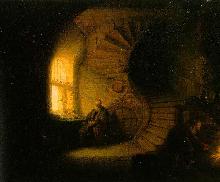
Home | Online Gallery | Online Art Store | Message Board | Art Club | Articles | Gallery List | About Dimahne
Did Rembrandt get his inspiration for the "Philosopher in Meditation" from the Yin-Yang symbol?
by David Kelley

Home | Online Gallery | Online Art Store | Message Board | Art Club | Articles | Gallery List | About Dimahne
Did Rembrandt get his inspiration for the "Philosopher in Meditation" from the Yin-Yang symbol?
by David Kelley
 "Philosopher in Meditation" by Rembrandt |  Yin-Yang Symbol |
When I first looked at the "Philosopher in Meditation", I was struck by the gentle glowing reflected light which resonates with the quiet absorption of the two people in the room - both apparently lost in private reverie. Then it became apparent to me that each person had their own source of light - the man illuminated with heavenly light, the woman illuminated with the hearth light.
I started noticing how many circles there were in the composition and how the arched window created a large circle of glowing light in the room. How both the man and woman had conspicuous circles located above their heads to the right. At first I thought the spiral staircase was symbolic of the ascending nature of contemplative thought - each insight building and ascending with each step. But then I noticed that the spiral cut the entire shape in a curious way that reminded me of the yin-yang. Once I saw this I became persuaded that maybe this was Rembrandt's intent.
I looked up yin-yang and found that the yin is associated with the earth, female, dark and passive and that yang is associated with male, light, the heavens, and is active.
Then I thought more about the composition and the sources of light in the painting. The man is illuminated by the light from the heavens and is in the lighter side of the room. The woman is illuminated by an earthly light and is in the darker side of the room. The spiral staircase demarks the lighter half from the darker half creating a shape very close to the yin-yang. The circles near the man and woman's head represents the smaller circles embedded in the yin-yang. The man is contemplating in an active focused way in his studies-his book propped open next to him. The woman is absorbed in a more passive reverie. Both are encased in a large circle which is very apparent in edge of the light in the left side of the painting.
So does the painting simply resonate with the duality which is explicit in the yin-yang concept, or, was Rembrandt aware of the symbol and incorporated in intentionally?